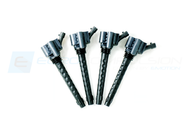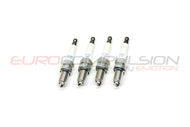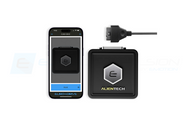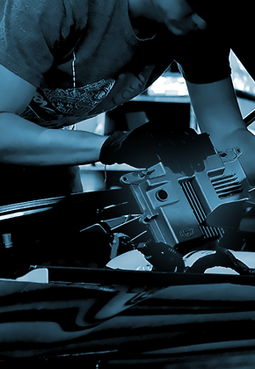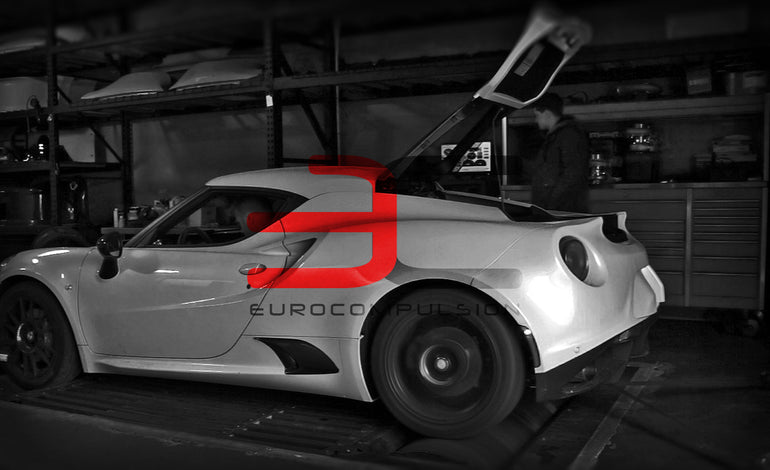
I originally wrote this article when we started running into Dyno issues on the 500 Abarth back in early 2014. At that time when I said the Abarth knows when it's on a dyno and pulls power back, some people thought I was crazy. Thanks to VW's Diesel Gate saga, it's now well known that certain modern cars can run different maps and or limiters when on a rolling road type dyno. This fact just isn't open for debate anymore.
At this time it seems that all of the current FCA group turbo cars do this. Once you go above stock boost levels with a Fiat 500 Abarth, Fiat 124, or Alfa 4C and the car senses it's on a dyno it will pull back power making accurate dyno testing very difficult. We do have a solution, which I will explain in this article. What's more, it's a very inexpensive and reliable solution that allows anyone with a laptop to duplicate our testing methods and verify our results.
This is a complex subject, and I will simplify it to an extent, but it really is important to understand this stuff in order the make educated decisions about performance products.
It’s a good idea to review some basic principles about horsepower and torque. A lot of people don’t understand the difference between these two things and their relationship. Horsepower is a measurement of work being done in a period of time. One horsepower gives the ability to lift 550 pounds one foot vertically in one second. Torque is a simple measurement of the amount of force that being applied without regard to how much it moves in a give time period.
To understand the difference between horsepower and torque I will compare the Abarth engine to Sean. Sean works in my shop and is 130 pound cage fighter so he is small, but pretty strong. The Abarth engine in stock form is rated at 160hp and 170 foot pounds of torque at the flywheel. I have seen Sean use a torque wrench and get over 200 foot pounds of rotational force on a bolt. That means that with the wrench Sean can generate more torque than the Abarth’s engine. So if Sean can put out more torque than the engine, and he weighs less, could we pull out the engine, put Sean in Fred Flintstone mode and have a faster car? Of course not, this is where horsepower comes in.

Now, let’s ask Sean to put 100 ft pounds of torque on the bolt AND spin it at 3000rpm. He can easily generate the 100 pounds of torque, but he just can’t accelerate it to that speed. He doesn’t have the horsepower. The Abarth’s engine can easily put out 100 pounds of torque and accelerate the crankshaft to 3000 rpm and beyond. In short, Sean can move the car, he can easily generate enough torque, but he can’t accelerate it very well.
Horsepower can be correctly thought of as Torque corrected for RPM. The actual formula is as follows: HP=Torque x RPM/5250. You can see that RPM has a major effect on horsepower at a given level of torque. At 100 pounds of torque at 2000 rpm the engine would have 38 horsepower. At 4000 rpm and the same amount of torque it would have 76 horsepower. How fast could Sean spin that bolt while putting out that much torque? I am not going to ask him to do it, but I doubt it would be enough to generate much more than 1 horsepower.
To put it in practical terms, torque can be thought of as low rpm power. While that’s not exactly correct in a technical sense, it does help to think of it that way. Power and torque (when torque is measure in ft pounds) will be equal at 5250rpm. Above that RPM torque will always be lower. That means if your car has a high peak torque number relative to peak horsepower, it makes its power down low. For example an engine with 400 lbs of torque and only 150 horsepower MUST be a low rpm engine, because if it made that torque number anywhere near 5250rpm, the power would be higher. Conversely, an engine that makes 400hp at 9000 rpm probably won’t have a lot of torque down low.
Notice how much horsepower this Ducati engine makes but how little torque. That's a function of the RPM level at which is makes all that horsepower.

Now it’s time to think about measuring horsepower and torque. Most dynamometers measure one and then calculate the other. That makes sense right? If you have the numbers for one and you know the RPM where the numbers were generated, you can calculate the other. Dynos that measure torque calculate horsepower based on the formula, HP=Torque x RPM/5250. Dynos that measure horsepower calculate torque based on the following formula Torque=HP x 5250/RPM.
Factory power ratings in modern automobiles are for numbers generated at the flywheel. We as enthusiasts can’t easily measure power at the flywheel because it would require removing the engine, and fabricating adapters to harness it to the engine dyno.
Engine Dyno:

A much more practical way to do it is with a chassis Dyno. These devices measure power at the wheels. Power at the wheels is always lower than at the flywheel due to driveline losses. There are basically two categories of chassis dynos. Let’s call these two categories, loading type and inertial type dynos.
The first category “loading type” measures torque by applying a load to the rollers and it essentially measures the force, or torque the car’s drive wheels apply. It then calculates horsepower. This type of dyno is the less common and more expensive. It’s also generally less consistent from run to run, and from dyno to dyno. However it has the advantage of being able to hold an engine at full power and at a given rpm which provides tuners with some advantages.
Here is a Dastek Loading Type Chassis Dyno:

The inertial type is the much more common chassis dyno. Its operation is simple, it uses a relatively large and heavy roller. A computer measures how fast the roller is spun up and it measures engine RPM. Since the weight and resistance of the roller are known, it’s a simple math calculation (for a computer) to calculate horsepower and torque.
The Dynojet brand dyno is probably the most common inertial type dyno.

The Dynojet itself if very consistent from run to run because the weight of the roller doesn’t change. There are some minor run to run variations in bearing and brake drag (the roller has its own brake) but these are pretty minor.
Dynoing the 500 Abarth, 124, and 4C (from now on I'll just say Abarth, but the info applies to the 124 and 4C as well)
The Abarth does present some minor problems on the dyno and some major, somewhat unique problems. EC has dynoed this car more than almost anyone outside of Fiat, and we've learned quite a bit about the car as a result.
As with all modern cars, heat built up is a big factor. At the high end of third gear the Abarth would normally have about 80mph of airflow over the car and into the radiator and intercooler openings. At the dyno, the fan provides at best 10mph of airflow. This means the radiator, intercoolers, oil cooler, and just about everything under the hood gets pretty hot. This heat reduces power in a number of ways. Not only is the air less dense, but like most modern cars the ECU pulls out timing. The coolant temp starts to rise, and sometimes that kicks on the cooling fan which sucks almost 5hp right there. The shop fan is usually shaped and positioned to blow air onto the radiator. As the Abarth’s intercoolers are not in front of the radiator they get almost no fan air when on the dyno (with the 4C this problem is worse, with the 124 it's a little better).
In the past we mitigated the heat issue by simply waiting long enough between pulls for the temps to drop back to our baseline values. If the fan kicked on it was a wasted run and we discarded it. No matter what, intercooler temps would always rise a lot more during a single dyno pull than they ever would when on the road. The temperature issue with this car on the dyno is a problem but at least it’s measurable and controllable. However there is another much bigger problem.
The main problem with this car on the dyno is the ESC system. To start with, you have to dyno it with the ESC fully off, meaning hold in the button for 10 seconds until it beeps (just press the button in the 124, if you hold it for 10 seconds it does something you don't want on the dyno). If you do that you can dyno a stock or mildly modified car without any real problems.
The ESC is connected to the engine’s ECU, and even though you shut off the ESC, it’s really not fully off, it’s still awake and monitoring things, which it sort of has to be because the ABS will still be working. As soon as the drive wheels start to roll, the car starts to get upset because it knows the other wheels are not turning. The first thing you will notice in terms of engine operation is the rev limiter becomes disabled. Even though the ESC is off, it’s really awake, and it thinks something is wrong.
Now as I said earlier, on a stock or nearly stock car, this isn’t a problem. If you are testing air intakes, or exhaust mods, the ESC won’t cause you any problems. However when testing RRM’s piggyback box (solid product) we started to notice hints of some strange "dyno-only" phenomenon. When developing our own tunes we ran into this problem head on and put a lot of effort into figuring it out. I don’t want to explain exactly what happens because I don’t want to give competitors a heads up on figuring this out (especially because most in North America deny this to be a factor), but the gist of it is that above a certain power level under certain conditions and especially when also above about 4500rpm the ECU will pull things back if the ESC system isn’t totally happy.
We tried various work arounds, including pulling fuses and disconnecting the wheel speed sensors. None of these things worked satisfactorily. This left us with a few options. As a side note, pulling the anti lock and stability control fuses works with a lot of cars, but it doesn’t solve all the issues with this one. If you don’t believe me, drive the car that way and you will notice how differently the throttle behaves. Even simple things like matching rpm when shifting will be a lot different. The bottom line is that the FCA ECUs on these cars are “fail safe” meaning that if they don't see correct signal from the wheel speed sensors, they assume there is slippage. Because of that “fail safe” system logic, simply disconnecting the sensors doesn't work.
We considered making a wiring harness to connect the front and rear wheel speed sensors using a “signal booster” so the ESC system wouldn’t know the difference. I think this would work, but logistically it was difficult to pull off (the signal booster is tough to get) and wouldn’t be easily duplicated by our customers. That last reason alone is reason enough for us to skip this option. If we come up with a way to measure power that only we can use, that doesn’t do our customers a lot of good.
Another option is to use a dyno with dual LINKED, CALIBRATED, and MONITORED rollers. Not a typical AWD/4WD dyno, but something more advanced. Dimsport makes such a dyno. They are common in Europe, but it's very expensive to attain and import, hence why almost no one in the US has one.
Still another option with flash tuning was to and make a different map just for dyno testing with a fix or patch installed in the calibration. One that would replicate the engine parameters we have on the real road. In other words, force it to hold certain timing, boost, throttle, Lamda or whatever value regardless of what the ESC is trying to do. We had some real arguments about this, but the idea was rejected. We certainly don’t want to mess with the factory’s ESC calibration as we think they have that right. If we make a dyno only map, then that would technically be a different map than the one we sell, plus customers couldn’t duplicate the results, so this was rejected.
At this point we started thinking, the Dynojet just does a simple calculation based on the time it takes to accelerate a known amount of weight. We know what the car weights, we know the gear ratios and everything else, shouldn’t one of these tablet apps be able to do this calculation for us? We have both “Torque” and “Dash Command”, both have a sort of dyno built it, but will it work for our purposes? The answer is no.
The problem is that these apps don’t calculate horsepower based on the time it takes to accelerate anything. They base it on fuel flow. In a technical sense, that’s a perfect way to do it. In practical terms, for our purposes it just won’t work. The idea is that the app knows fuel flow based on fuel injector duration and other factors. Assuming the injectors are in tip top shape, that means the app knows just how much fuel is going into the engine. So far, so good because a given amount of fuel when burned puts out a given amount of horsepower.
However, this idea starts to fall apart pretty quickly. These apps need to know the brake specific fuel consumption of the engine. This is a measurement of how much of the fuel’s energy reaches the flywheel. It’s probably about 50% meaning to generate 100 flywheel horsepower we need to burn 200hp worth of fuel, which would give us a BSFC of .5. That’s just a guess; it could be better or worse, so our initial number would be off by some amount. However, it’s even more complex than that. The BSFC isn’t constant throughout the rpm range in this engine, not even close and there is no adjustment for that.
An even bigger issue, is that even if we got the BSFC exactly right on a stock engine throughout the RPM range at full throttle, it would change with mods. Think of it this way. If we decided to just make the car run way too rich, power would suffer, but if we measured power only by looking at fuel flow, we would think power went up. Or, if we got an increase in power by adjusting the timing, but fuel flow stayed the same, we wouldn’t see that increase in power via the app. With most of our tunes we do play with timing and other parameters so these two tablet apps just won’t work for us in terms of mapping power. In defense of these two apps, they do many other things very well, and I strongly suggest owning them, just don’t rely on them to reliably measure power from mods.
THE SOLUTION:
I am sure some of you have just skipped ahead to this point. If so that’s fine, but I encourage you to read this entire article to understand the logic here.
It turns out a few companies make software for a laptop that will do this job. They measure acceleration by monitoring the rise in engine rpm. If all the relevant data is put in correctly, that means its calculating horsepower exactly the same way an inertial dyno does it. Now there is a lot of data that has to be correct, vehicle weight, drag information, gearing etc. but if it’s all spot on the program works perfectly. There are some variables we will have to address, but that’s true with any dyno.
Does this really work? In theory yes, it should work perfectly. It turns out it works very well in real life. It’s not just my opinion; various magazines have tested this stuff as well. For example Import Tuner tested the Nology Laptop dyno and found it within about 1% of a Dynojet. In our own testing we found the numbers were near the Dynojet, and the run to run consistency was at least as good if not better. I also spoke with a highly knowledgeable, reputable dyno operator/tuner about the ESC issue and he informed me it’s becoming a bigger issue all the time. He is now using a laptop dyno for certain BMWs, and this is a guy who owns an advanced in-ground dyno! The software made by Nology is no longer available. We purchased our software from Auterra.
Now of course there are some variables.
First is wheel spin. If the wheels break traction, any measurements using this system are invalid. OK, that’s not a problem, just chose a high enough gear on a nice dry surface and this isn’t an issue. For all the cars we test, 3rd gear works pretty well.
The second is the road gradient. Obviously, if going up the Grapevine Hill you will get some falsely low numbers, although with Eurocompulsion products you will at least be passing cars like they are standing still (two years and counting and nobody got that reference, c'mon people!). So road gradients will throw off the numbers. The way to mitigate that is to choose the flattest road possible. Then do all your pulls on the same section of road so that even if it’s not perfectly flat the run to run comparisons will still be valid.
The third variable is air resistance. Well, more correctly it’s wind. The Auterra software corrects for air resistance in zero wind assuming you enter the data correctly, meaning frontal area and drag coefficient. However, if you have a headwind, or tailwind, that will throw off the results a little. You can minimize this by averaging two way runs, or do what I do. Do the runs in the early morning when the wind is usually calm.
All together these variables are pretty small, and all are easily mitigated. I think they are actually smaller than the variables caused by the temperature issues alone on the dyno. No method of measuring power is perfect, but this method works well for our cars, and it’s easily done by our customers.
Sadly for a lot of shop owners, their 1980's technology Dynos are becoming obsolete for use on a number of modern cars. Auterra is modern software, that in my opinion any serious auto enthusiast should have. In addition to measuring power, it can measure acceleration log data, check the readiness monitors, and read codes associated with the check engine light. Short of owning the latest type of dyno with linked and monitored rollers, I think it's about the best thing you can use.
How do the numbers for Auterra compare to a Dynojet? Assuming both are set up correctly they will be very close on a normally aspirated car. As I mentioned earlier, they are typically with just a few percent of each other, and either could be higher. However on a turbocharged car, the Auterra results will almost always be higher because most dyno shop fans just can't compete with the 80mph of airflow you get through the intercooler when using Auterra.
Here is a comparison of results from our STOCK Fiat 124 using both Auterra and Dynojet. Notice the results are very similar until about 4000rpm. At that point, due to airflow and the ECU pulling power back slightly, the results on the Dynojet fall behind. Peak horsepower on the Dynojet was 136, vs. 149 on Auterra.

The raw dyno data for the results above can be found in our Dyno Database. I simply transposed them onto a single chart for easy comparison, there are some very minor rounding and chart interpolation variations in this chart. It's interesting to note just how close the results are until about 4000rpm. Then they diverge a little but are still within about 5% of each other and ultimately end up about 9% apart.
So what about on a modded car? Here the differences are huge. Again, at the low end, they are pretty comparable, but the dynojet shop fan just can't keep the intercooler temps/pressure in check, so it lags behind. Then at 4250rpm, the ECU starts to pull things back. At 5250 the ECU says NOPE, and ends the fun.

Since this comparison is taken from customer results, they are not currently in our dyno database, so I'll put them here for convenience.


I also need to mention that the more powerful the tune, the more the ECU tends to pull things back when on a dyno. This can results in a more powerful tune showing lower results in testing. As an example, our highest every Dynojet result on a tuned 1.4 turbo was with “The Claw”, a MBC which was discontinued, but it certainly never had the power of our Flash tunes. Basically, on a highly modded car, the rolling road type dynos just can't be used for accurate measurements OR COMPARISONS on some of these vehicles.
Even in light of these issues, we have continued to use a combination of both traditional rolling road dynos (like Dynojet), as well as road testing simulation with Auterra. We feel this is the most accurate method of testing because it allows us to consistently replicate results, identify variables, and understand even more how a vehicle's ECU and electronic systems are working in regards to performance. This is extremely valuable information, allowing for increased effectiveness when developing performance parts or ECU calibrations.
That's the end of this article. Thanks for reading it. Hopefully, it explained how we test and why we do it that way, and I hope you go out and buy Auterra. We at Eurocompulsion try to be as transparent about what we do as possible. If you have any questions about dyno testing with these cars, please ask.

